Related Research Articles

The Westland Whirlwind was a British twin-engined fighter developed by Westland Aircraft. A contemporary of the Supermarine Spitfire and Hawker Hurricane, it was the first single-seat, twin-engined, cannon-armed fighter of the Royal Air Force.
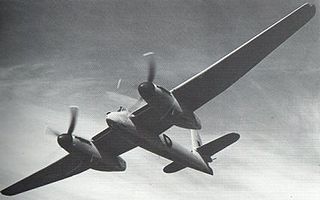
The Westland Welkin was a British twin-engine heavy fighter from the Westland Aircraft Company, designed to fight at extremely high altitudes, in the stratosphere; the word welkin meaning "the vault of heaven" or the upper atmosphere. First conceived in 1940, the plane was built in response to the arrival of modified Junkers Ju 86P bombers flying reconnaissance missions, which suggested the Luftwaffe might attempt to re-open the bombing of England from high altitude. Construction was from 1942 to 1943. The threat never materialised; consequently, Westland produced only a small number of Welkins and few of these flew.

The Westland Widgeon was a helicopter developed by Westland Aircraft as a private venture improvement on the Westland WS-51 Dragonfly.

The SZD-45 Ogar (Hound) is a T-tailed cantilever high-wing monoplane of wooden, aluminium and fibreglass construction designed and manufactured in Poland.

The Aerosport Scamp A is a small biplane designed for home building by Harris Woods. It featured an open cabin, tricycle undercarriage, and a T-tail.

The LIPNUR Kunang was a single-seat sports aircraft built in Indonesia that first flew in 1958 in the hope that it would inspire interest in aviation amongst Indonesian youth. The only example that was built was subsequently grounded. It was a single-seat monoplane of conventional layout with fixed tailwheel undercarriage.

The Brügger MB-1, MB-2 and MB-3 Colibri is a family of small sports aircraft designed in Switzerland in the 1960s and 1970s for amateur construction.
The Clutton-Tabenor Easy Too was a small homebuilt aircraft under development in the United Kingdom in the late 1970s. It was intended to be a flying showcase for designer Eric Clutton's adaptation of the Volkswagen air-cooled engine as a geared aero-engine. The lines of the aircraft were influenced by the Percival Mew Gull racer of the 1930s, but it was to have retractable undercarriage. The wings were designed to be folded to allow the aircraft to be towed behind a car.
The Harmon Mister America was a 1970s American single-seat light sports aircraft designed by James B. Harmon. Plans for home building were made available from the Harmon Engineering Company. It is a mid-wing cantilever monoplane with a low-set tailplane and a fixed-tailwheel landing gear. The prototype (N7UN) first flew in 1975 powered by a 60-hp (45 kW) 1200cc Volkswagen air-cooled engine.

The International F-17 Sportsman was a 1920s American three-seat open-cockpit biplane designed and manufactured by the International Aircraft Corporation in Long Beach, California and Cincinnati, Ohio. 107 aircraft were built, 77 of them at Cincinnati.
The Fauvel AV.45 was an unorthodox motor glider produced in France in the 1960s and 1970s. Like other Charles Fauvel designs, it was a tailless aircraft, in this case inspired by the work that German firms had done on producing motorised versions of his AV.36 design. The prototype of the AV.45 was an extensively modified AV.36 powered by a Nelson H-59 two-stroke engine. AV.45s have been built with a number of other engines, however, including at least one aircraft powered by a small turbojet. Falconar marketed the plans in the 1970s.

The Focke-Wulf A 20 Habicht was an airliner developed in Germany in the late 1920s. It was a high-wing cantilever monoplane with fixed tailskid undercarriage. The fuselage was deep and seated four passengers in a fully enclosed cabin. The type was not bought by the airlines and only a few examples were built.
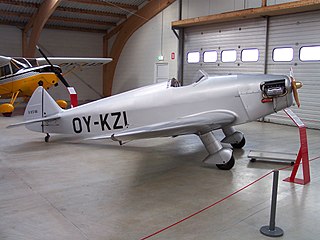
The SAI KZ I was a sport aircraft built in Denmark in 1937, the first aircraft built by the Kramme & Zeuthen firm.

The Valentin Taifun is a two-seat self-launching sailplane designed and built by Valentin Flugzeugbau GmbH of Hasfurt, Germany.
The Pazmany PL-4A is a single-seat, single-engine sport aircraft developed in the United States and first flown in 1972. It is marketed for homebuilding from plans, and 686 sets had sold by 1985. The PL-4A is a conventional, low-wing cantilever monoplane with an enclosed cabin and fixed, tailwheel undercarriage. The design features a T-tail, chosen to facilitate folding the wings. Construction throughout is of metal, using standard extruded sections for the longerons and pop rivets as the basic fastener. The standard powerplant is a Volkswagen air-cooled engine of 60 hp (45 kW) Construction time is estimated to be around 1,000–1,500 hours.
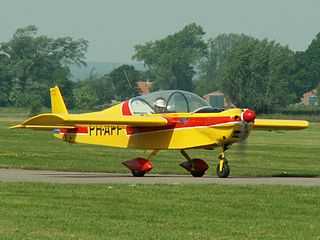
The Pottier P.70 was a single-seat, single-engine sport aircraft developed in France in the 1970s and marketed for homebuilding. It was a mid-wing cantilever monoplane of conventional design with an enclosed cockpit. Originally designed with fixed, tricycle undercarriage, the plans were later revised to offer a fixed, tailwheel option. Construction throughout was of metal. A two-seat, tandem version was developed as the P.170.
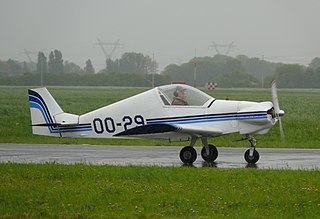
The Pottier P.80 is a single-seat, single-engine sport aircraft developed in France in the late 1970s and marketed for homebuilding. Ultimately based on the P.70 design, it features a redesigned wing and cockpit canopy. The P.80 is a low-wing cantilever monoplane of conventional design with an enclosed cockpit. Construction throughout is of metal. The prototype was constructed and unveiled at the 1977 Paris Air Show.
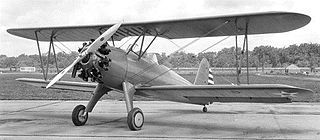
The St. Louis YPT-15 was an American two-seat primary training biplane, built by the St. Louis Aircraft Corporation for use by the United States Army Air Corps. 13 examples of the type were acquired, serving in the late 1930s.

The W.A.R. FW-190 is a half-scale homebuilt replica of a Focke-Wulf Fw 190 fighter. In July 1973, War Aircraft Replicas International of Santa Paula, California began design of an approximately half-scale replica of the Fw 190, the first of a series of replicas of World War II aircraft using similar constructional techniques. The first prototype made its maiden flight on 21 August 1974.
The Ekin WHE Airbuggy is a British single-seat autogyro designed and built by the W. H. Ekin (Engineering) Company in Northern Ireland.
References
- Taylor, Michael J. H. (1989). Jane's Encyclopedia of Aviation. London: Studio Editions. p. 225.
- Jane's All the World's Aircraft 1985-86. London: Jane's Publishing Company. p. 583.
- Langhurst, Louis F. (1983). Military Aircraft Replicas: A New Era in Flight.